#St Ninian's chapel
Explore tagged Tumblr posts
Text
Early Redwall Weirdness
Veterans of the Redwall fandom know that there's quite a bit in the first Redwall book that didn't carry over into the rest of the series.
One chapter mentions St. Ninian's as having a lady chapel, a feature in Roman Catholic and Anglican cathedrals, being a chapel dedicated to the Virgin Mary.
This implies the existence of a mouse Virgin Mary and a mouse Jesus who died for our mouse sins.
116 notes
·
View notes
Text





St Margaret's Chapel Stained glass windows, Edinburgh Castle today.
The smallest and the oldest surviving building in Edinburgh.
When the Castle was captured by Sir Thomas Randolph in 1314 on behalf of King Robert, it was the only part of the Castle spared destruction.
It contains five stained glass windows by Douglas Strachan, depicting St Margaret, St Andrew, St Columba, St Ninian and William Wallace, these are a modern addition and in my opinion add a lot to the building.
St Margaret's Chapel may not hold any real religious purpose nowadays, but I have been in The Castle when a wedding took place and the piper playing that day was a Ghurka.
11 notes
·
View notes
Text
Shetland
We took the overnight ferry from Kirkwall, Orkney, to Lerwick Shetland, arriving at 7 AM. We then headed straight out to Old Scatness, an Iron Age village and broch that our tour leader, Val Turner, had excavated.
We got a good description of the site and a discussion on the excavation and the decisions regarding the excavation, preservation, and display of the site. Those objectives are frequently in conflict. For a purely archeological dig, an excavation down to virgin ground would provide the most information but would destroy the upper levels, preventing further analysis of those layers in the future and presentation of them to the public. Presentation to the public might require restoration of fallen walls, the creation of safe passages, etc., disturbing the site. Leaving the site open exposes it to the weather and further decay. There is no perfect answer.
The walls are not as well preserved as at some of the other sites, making it harder to understand. It is even harder in photos. So here is an aerial of the site for better orientation.

You can see that some houses intersect with others while others squeeze into spaces. This shouldn't be a surprise in a location that has been used for hundreds of years. The large circle in the top center was a Pictish broch, which had lost its function as a defense structure. The interior was remodeled in at least two different forms.
At the center of that, you can see the curved edges of the open space. This is referred to as a wheelhouse, and those spaces had a corbelled roof over them, a design that developed between the Neolithic and Iron Ages.
Here Val demonstrates the concept.

Recreations of a wheelhouse were built and really help to understand that concept.



A model also helps understand the broch.

It struck me that in this part of the world, people changed from very temporary structures and a module life to stone structures that were used for hundreds to thousands of years. They then used those same basic designs for over 3,000 years.
We then went to St. Ninian's Isle, which is connected to the mainland by a strip of sand with beaches on both sides.
There we had lunch at the ruins of a small Christian chapel famous for a hoard of silver objects found under the floor.

We then drove to the east coast of the island and took a small ferry to the Island of Mousa, a bird sanctuary and the location of the best-preserved broch on Shetland.

There is also the ruin of an 18th-century house nearby.

The broch is in very good shape possibly a result of its remote location and the good quality of the local stone.

The interior is also in good condition.

There were more openings in the interior layer of walls than I expected. Some were probably storerooms, and others were staircases to the upper floors and even to the top. The broch had been used by seabirds for many years, so when the inside was cleaned out, there was a lot of guano! Luckily, that was all gone.
The floor is higher than the original, so it was even taller on the inside. It's quite a work of drystone masonry.
1 note
·
View note
Text
In the Footsteps of the Saints
The Machars of Galloway have a long association with St Ninian (whose shrine in Whithorn was once the prime pilgrimage site in Scotland) and other early Christian saints. Throughout the Summer we are offering a programme of short pilgrimage-style events at various sites around the area. These will involve a walk of around half an hour in the beautiful Galloway countryside, pausing along the way to connect with our surroundings and the spiritual dimension beyond, and will each conclude with a short act of prayer and reflection at a particular holy site. Where possible these will link in with the weekly Ninian Moments acts of prayer inWhithorn and Wigtown.
Some events will be dependent on the tide to allow access to parts of the route so it is not possible to give exact times in advance - see website.
All events are open to locals and visitors alike and are free of charge (donations welcome). Please dress for the weather. Stout shoes are advisable. You participate at your own risk.
First Tuesday of the Month
St Ninian and the church in Whithorn
Meet at Rispain Camp (between Whithorn and Glasserton) at 10.45am
Third Tuesday of the Month
Various locations, including Physgill Glen & Ninian’s Cave, St Medan’s Church & Well, Isle of Whithorn & St Ninian’s Chapel
(Please see our website for details)
Mondays 8 July, 26 August, 30 September
The Wigtown Martyrs
Meet at Wigtown Market Cross at 10.45am

0 notes
Text
On St Ninian’s Beach
26th June 2023
I had booked the most basic accommodation on the overnight boat from Kirkwall to Lerwick, a reclining seat. But I had hoped not to use it, preferring the illegal option of staying in my van bed. I had researched on the internet and read that it was something truckers did do. An article from an incident in January of 2006 was easily found, when in stormy conditions three trucks had toppled over during the crossing. On arrival in Lerwick it was found 6 drivers had stayed in their cabs, one stuck there until he was rescued.
Northlink stresses how dangerous it is, yet they are quite happy to let my dog stay there.. do they value his life any less than mine? By circumstance rather than choice, I boarded last, and had to reverse on with the studious attention of all the boarding crew. At the appropriate moment I disappeared behind the curtain. They either didn’t see, or weren’t bothered. Before the boat sailed I was in bed, waking at 7:15 am as drivers returned to their vehicles. The coach driver next to me gave me a knowing nod. It was clear he had done the same.
By 8 am I was at St Ninian’s Beach, about a half hour drive away, in heavy rain and just 9C. Roja and I had breakfast, and I read while Roja dozed and the rain eased, and by mid-morning the cloud cleared and the sun emerged.
This is my second visit of the year to the Wild Atlantic coast, the first being the Costa del Morte in Galicia in February, equally impressive.
The first photo is of the ruin of St Ninians’s Chapel, which dates back to the 12th Century. Before that it was an Iron Age Burial Ground. It’s other claim to fame is that in 1958 a local schoolboy found a wooden box on the site, which contained 28 silver objects of Pictish treasure.

St Ninian’s Isle is quite a spectacular sight from the car park, with its jagged rock cliffs, strikingly green pasture, and it’s shell-sand tombolo, the finest example of one in Western Europe. It is occasionally breached, in storms and at high tide, but today it was at its best, a superb wander though Roja chose not to use it and swim alongside for most of the way.

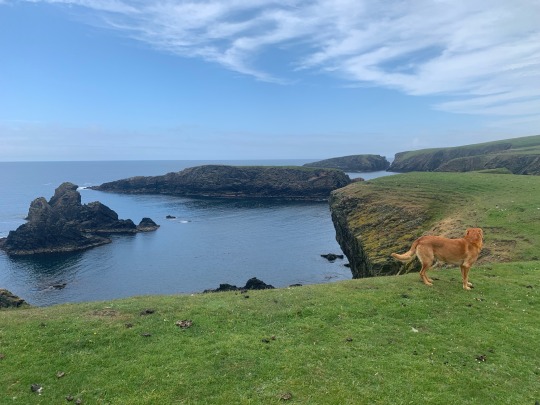

The perimeter of the Isle is about four and a half miles, but most who walk as far as the island, then choose shortcuts. As with most of the ocean facing coasts here, the south and west headlands are the wildest and most spectacular. There were a few other visitors. I met the couple in the other campervan at the carpark, from Durham, and prior to that at Dentdale, and we chatted for a while.



We were back at the van for 2 pm, and spent the afternoon with the dramatic backdrop trying to concentrate enough to attend to a few business matters.
Last week here was the Shetland Noir Book Festival, attended by writers such as Martin Edwards, Val McDermid, Ann Cleeves and Elly Griffiths. They even had a session here at St Ninian’s Beach. Cleeves write the Shetland series, that has now been adapted for television. It strikes me that the literary body count here on the tranquil Shetland Islands is bigger than most places, with the possible exception of Midsomer.
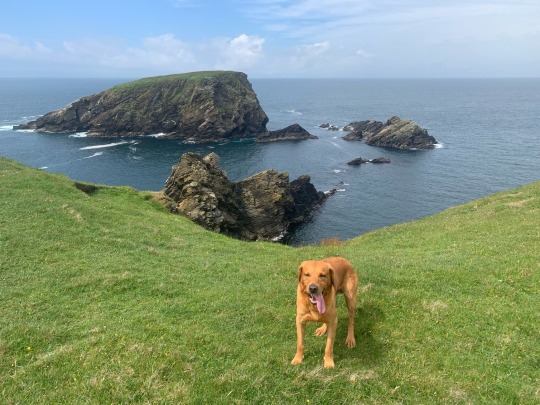
These rocky outcrops put me in mind of Chris Cameron, who is currently mid-way through his 60 day record attempt for the longest stay on a remote uninhabited North Atlantic rock, on Rockall, 200 miles west of St Kilda, and 300 miles from the mainland. It says a lot about the teaching profession that a guy has to go to such lengths to get a peaceful break. Maybe he won’t return to his post, and stay on Rockall.
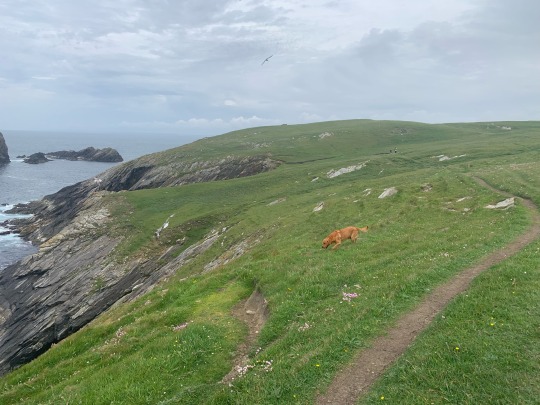
Roja seems unbothered by the various dive-bomb attacks from the sea birds he receives. They concern themselves with him rather than me thankfully. With my untrained eye, those who bombed him include, the Fulmar which comes off the cliffs and hovers in the wind, the territorial Curlew with its recognisable squeal and curved beak from the scrub land, and the much rarer Arctic Tern from its slumber in the grass.
And a ‘spot-the-van’ pic..
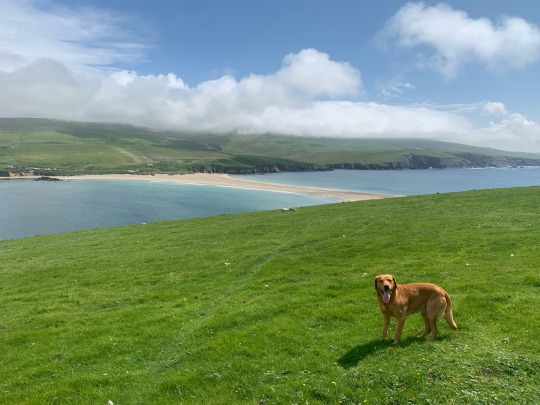
1 note
·
View note
Photo

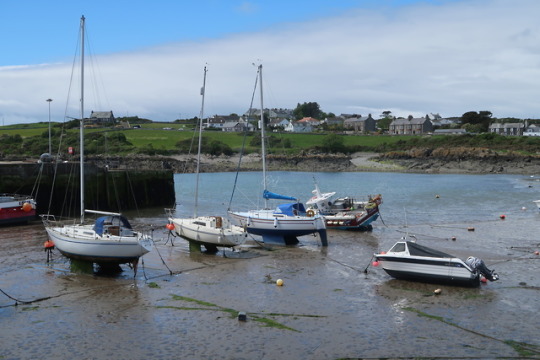

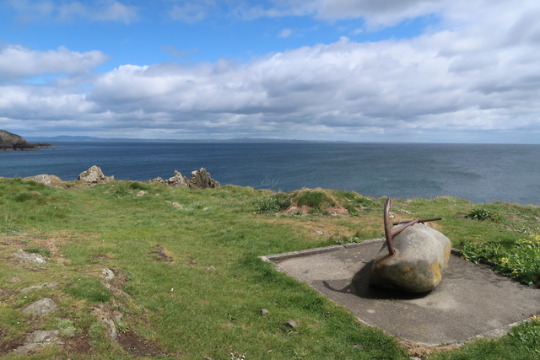


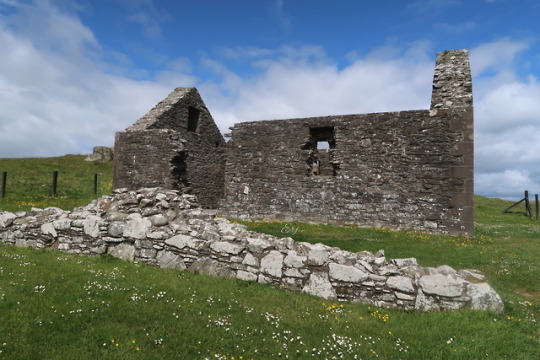
26/5/19
We wandered around the picturesque harbour town at the Isle of Whithorn, where the ruins of St Ninian’s chapel stand.
#St Ninian's chapel#Isle of Whithorn#whithorn#scotland#harbour#coastline#Journal#Bucket List#bucketlist#sea#travel#britain#galloway
1 note
·
View note
Photo
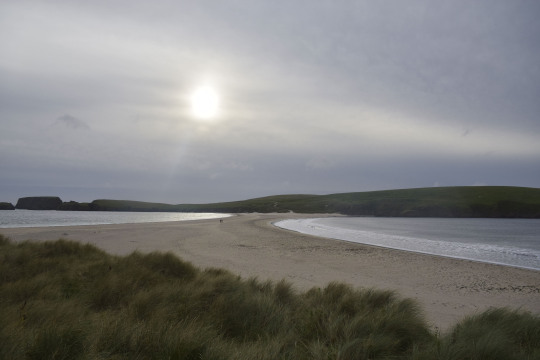
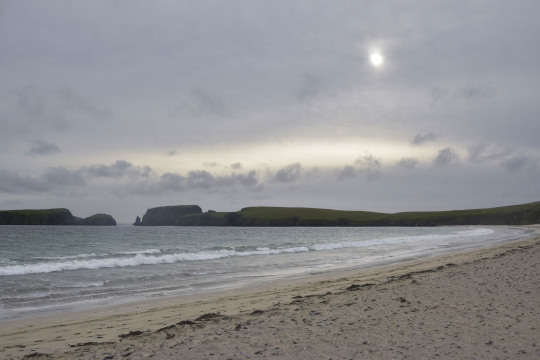



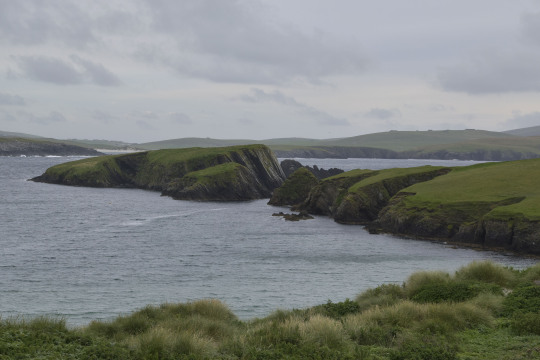


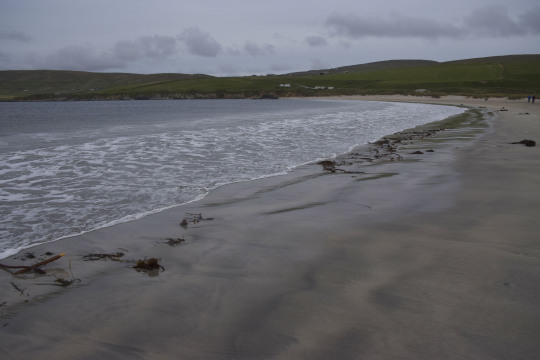

St Ninian’s Isle, Shetland
This island can be reached via a 'tombolo’, which forms this interesting X-shape. (A ‘tombolo’ is a strip of land, often created through deposited material over time, which attaches an island to the mainland, creating a ‘tied island’.) There you find the remains of a 12th Century chapel, dedicated to St Ninian. On the 4th of July 1958 a local schoolboy by the name of Douglas Coutts discovered treasure under a slab marked with a cross on the chapel site. It turned out to be 28 pieces of Pictish silver artefacts, many of them jewellery, and the jawbone of a porpoise. This treasure was likely hidden during a Viking raid around 800 AD. The original items can be seen in the National Museum of Scotland.
Video footage here.
#st ninians isle#shetland#visitshetland#scotland#island#nature#sea#beach#waves#tombolo#chapel#medieval#history#archaeology#treasure#hoard#pictish#picts#artefacts#photography#nature photography#travel photography#photographers on tumblr
321 notes
·
View notes
Text
thinking about that Redwall post about mouse christianity/the mouse pope/henry the 1/8th
and listen. the redwall mice Are Not christian. they don’t seem to hold any sort of religious services at all. there’s no mention of a higher power; every “prayer” is a call to appreciate the bounty of nature & provide for those in need. their feast days are based around the cycle of the seasons, the sowing and the harvest, not the lives and deaths of saints and martyrs
redwall is an abbey in name only, and it’s time we identified it as what it truly is: a secular utopian ecosocialist commune
#personal#keeping it fun and funky fresh#redwall#i mean ok there is that ruined chapel#st ninian’s#but nobody uses it as a church & there’s some comical tale#that a sign reading ‘’this ain’t ninian’s’’ was worn & weathered#until it read ‘’saint ninian’s’’#so i’m p sure there is no mouse christianity#successful posts#matty reads
691 notes
·
View notes
Text









St. Ninian's Ancient Chapel, The Isle of Whithorn, Dumfries and Galloway, Scotland
#ancient living#ancient culture#ancient craft#early religion#early christianity#early cross#chapel#church#coastal#landscape#archaeology#ancient scotland#wild places#nature
226 notes
·
View notes
Photo
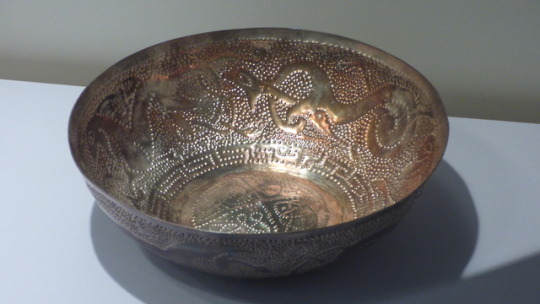
Today’s Flickr photo with the most hits - this shot of a silver gilt bowl; part of the the 8th CE hoard discovered in the ruined chapel of St Ninian, on St Ninian’s Isle, Shetland.
0 notes
Photo

Oh I do like to be beside the seaside! 🏖 When the sun shines Scotland literally has some of the best beaches in the world!! Seilebost Beach 📸 @thebigyin89 One of the top 10 beaches in the world, on a sunny day you could swear you were in the Caribbean not the Hebrides! Embo 📸 @larkandsea Near Dornoch and the famous @granniesheilanhame, is a great location to take the family for a holiday. Luskentyre Beach 📸 @cnesoutdoorlearning Another incredible Hebridean beach, luskentyre’s white sand and impossibly stunning blue-green water is also one of the worlds best beaches. St Ninians Isle 📸 @fozwoz Is a small tied island connected by the largest tombolo (a natural sand causeway with sea on both sides) in the UK, walk across to explore a rich Pictish treasure hoard within an ancient Chapel site on the island. East Beach, Lossiemouth 📸 @laurajg80 A lovely seaside town in Moray, East Beaches powerful waves makes it a popular spot for surfers and a haven for pods of bottlenose dolphins. Farr Beach 📸 @nicoljulia Found along the North Coast to the west of Bettyhill, while it is a trek to get to, it’s worth it for the spectacular views and epic waves. Ackmelvich Beach 📸 @rosiemiddleton On the West Coast, Ackmelvich is a beautiful sheltered beach with white sands and granite outcrops that divide the beach into sections and is framed by a mountain backdrop. Calgary Beach ���� @jake_t.h.o.mson Is the largest beach on the Isle of Mull, backed by a machair, a low lying fertile grassy plain, one of the rarest habitats in Europe, found only on the west coasts of Scotland and Ireland. Tolsta Beach 📸 @sailscotland On the Isle of Lewis Tolsta is one of three on this remote part of coastline, at the end of the beach are 5 caves known as the Caves of Life, which you can reach during low tide. Coldingham Bay 📸 @rafewelsh The most Southerly beach on this list, Coldingham Bay is near Eyemouth in the Borders and is a perfect place to catch the early morning sunshine and for exploring its many rock pools. Whats_Happening_Scotland #awayfromtheordinary #beach #visitscotland #explorescotland #staycationscot @VisitScotland @scotlandisnow @hiddenscotland (at Scotland) https://www.instagram.com/p/CQTXmxmj0pu/?utm_medium=tumblr
0 notes
Text
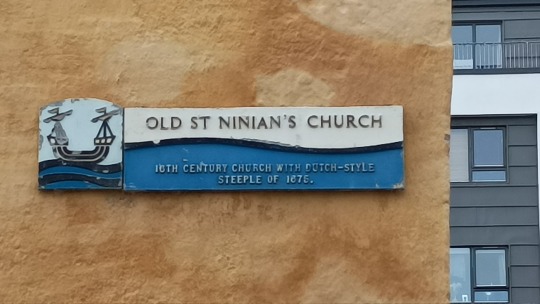


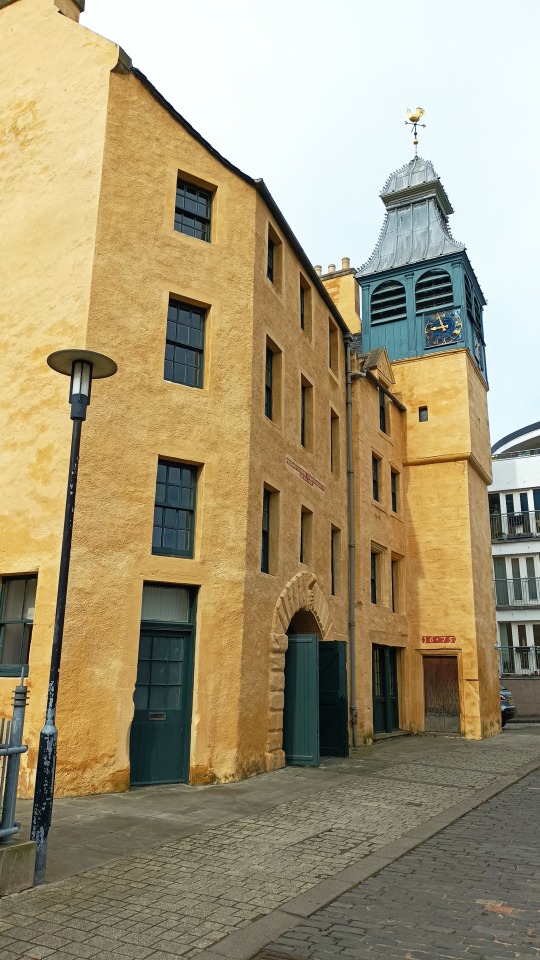



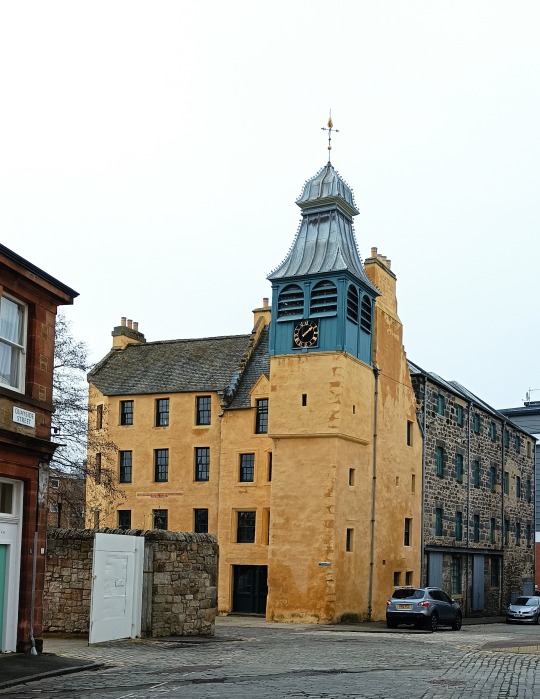

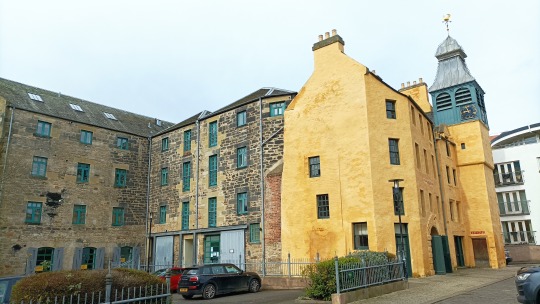
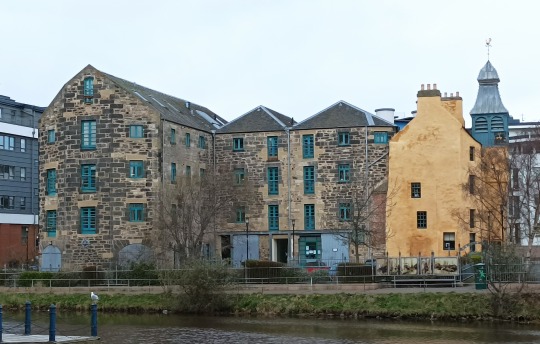
St Ninian’s Manse.
I've not had decent walk around Leith for a while so I remedied that today. My first point of interest is the former church, nestled amongst a cluster of modern buildings at Quayside Street off Sandport Place, while you can see the steeple, which I shal come back to later, easily enough from further afield, you won't find the Manse in full until you are almost on top of it.
The buildings origins lie in a chapel that established in the late 15th century, was the home of North Leith Parish Church, playing a vital role in the development of the area. It's importance is evident as it stands near the head of the first bridge to North Leith over The Water of Leith.
ln 1493 Robert Bellenden, Abbot of Holyrood, founded and endowed a chantry chapel. The chapel fell into ruin after the Reformation, it was restored in 1595, and in 1606 became officially the church of a new and independent parish of North Leith. The Statistical Account of Scotland states both the church and manse are as old as the times of popery, but they have undergone a variety of repairs; including a considerable one in the year 1736, when it was in a great measure rebuilt." In the early 19th century, when a new parish church had been provided on another site, the old one was let to other congregations; and in 1825, when the last of these left, the place was converted into a granary, which in its turn has been rebuilt as a mill, pics of it as a mill in the 1950-60's can be found by clicking here
The most impressive part of The Manse, to me anyway, is the aforementioned spire. If you look at it closely you will see it is made of wood. This is Leith's and so Edinburgh's sole surviving 17th-century timber steeple.
The entrance to the stair, now covered by an extension, is dated 1675 as seen on the lintel above the door. Another interesting feature is the inscription above an archway that says;
BLESED AR THEY YAT HEIR YE VORD OF GOD AND KEIP IT/ LVK XI 1600.
It comes from the New Testament bible by Luke, and quite literally translates to;
“Blessed rather are those who hear the word of God and keep it!”
The charity Scottish Historic Buildings Trust restored the building from 1996 to 2002 along with the adjacent Quayside Mills, creating desirable waterfront accommodation and office space. Much of the interior, from what I can see having trawled through a fair amount of pictures, retains a certain amount of it's charm, with many of the timbers visible throughout the building.
Some debate has gone on, due to the alterations over the centuries, whether this or Lambs House, a short walk away, on the south of the bridge is the oldest building in Leith.
Leith is usually thought of as the port or dock area of Edinburgh. It was not, however, part of Edinburgh until 1920. Between 1833 and 1920 Leith was an independent burgh. Before this Edinburgh town council was able to control Leith through being the feudal superior of the land there. Many of the citizen s to this day are fiercely proud of their old status, calling themselves Leithers, rather than saying they are from Edinburgh, it is apparent on the poem below I found on the Leith Forever web page, it was written in 1919 and appeared in Andrew Grant’s collection of poems from the Leith Observer 1914 -1920.
Ye folks a’ Leith, are ye a’ sleepin’
Whilst Reekie’s cheils are busy reapin’
Braw schemes to hae ye in their keepin’ For
evermair?
Arouse yoursel’s an’ dae the sweepin’
O’ your ain stair!
If ye yoursel’s wad save some siller,
Ye’d better tak’ in hand the tiller
Auld Reekie means to “droon the miller,” An’ sink
the mill;
For loaded debts noo fairly fill her-
They’re ‘yont her skill.
The debter’s grawvit’s rooned her neck,
An’ just tae save hersel’ frae wreck,
She offer ye her hindmaist cheque,
Frae some dark source.
But in nae bank, gi’en bow or beck,
Wad e’er endorse.
Keep clear o’ yon West-eny crew
O’ their “fine airs” hae nocht ado,
A keen East windblaws thro’ and thro’
Their mim-moo’ed graces;
Jist skin it aff, an’ then ye’ view
Some cranks in places!
Tak’ heed from Glesca’s swollen size;
Hoo burghs aince pride did prize
Lie low this day, an’ a’ their sighs
Speak o’ taxation.
This lesson ye maun ne’er despise
O’ ruination!
But rouse ye, toonsmen, ane an’ a’
An’ gie your pipes a warlike blaw.
Let ilka patriot in a raw
Tak’ up his stand;
Auld Reekie’s seekin’ for oor fa’
An’ wants command.
Ye craftsmen o’ oor ancient toun,
Your he’rts I ken are unco soun’,
It’s time ilka ane o’us marched roun’
Oor ain auld border;
An’ paced oor boundaries up an’ doon
In martial order.
The “honest toun” ayont oot by,
(Whaur danger’s likewise drawin’ nigh)
Has lately bade her burghers hie
To “ride the marches”;
Let Leith wi’ her auld neebor vie,
‘Neath hame-mad arches!
Let’ a’ meet at the Giant’s Brae
An’ mak the auld Port bricht an’ gay,
Turn oot in sold, massed array,
Mak’ Reekie quiver;
On each a badge, an’ let it say-
“Auld Leith for ever!”
Restalrig - 30 August 1919,
Next up I will post pics and history of the more well known, Lambs House.
28 notes
·
View notes
Text
Day 3 (14.1.18)
Come. It is time to keep your appointment with the Wicker Man.
When Ewan discovered that we were coming to Wigtown, he was very excited. Not just because of the books (although, let’s be honest, that’s the main draw), but also because parts of the Wicker Man (1973) were filmed around here. As part of our research for this trip, we looked into places nearby we could go and visit to connect with our inner Sergeant Howie (or Lord Summerisle).
When George welcomed us on Friday afternoon, he told us “the shop’s yours - run it how you want and, if the weather’s good, do go and explore”. Taking those words to heart, we’d been thinking about when we could fit in some sight-seeing amongst our bookshop duties.
Sunday morning in Wigtown dawned grey and misty. After a cup of tea, a quick look at the BBC weather app showed that there was likely to be a small window of non-rainy opportunity up to lunchtime. We took this opportunity with both hands, got in our trusty hire car (named Michael, after the name which appeared on the on-board computer when we started him up) and drove the 20 or so minutes from Wigtown to St. Ninian’s Cave.
Having parked in the remote car park (surprisingly, we were the only ones who ventured out on a misty Sunday morning), we followed the signs down a wooded path, alongside a stream, to a beach:

The signs then directed us right along the shore, to St. Ninan’s Cave itself. St. Ninian was first mentioned in the 8th century as being an early missionary among the Pictish peoples and apparently used the Cave to meditate. Later, in 1973, Robin Hardy used it as the beach at the end of the May Day procession in the Wicker Man. This was where Lord Summerisle rolls the barrel of beer into the water as an offering to the God of Sea; and where Rowan first appears in the mouth of the cave, apparently ready to be sacrificed. Here’s the Cave (described by 2 people on Trip Advisor as “disappointing” - but it’s not):


After scouting about the Cave for a bit, we wandered back up to the car and headed to the Isle of Whithorn. Various shots from the Wicker Man were filmed in the village but, more importantly for our purposes at this exact moment, it was a beautiful place with a renowned tea shop. We took shelter there for a bit before taking the short walk to St. Ninian’s Chapel:

Partly rebuilt in 1898, what stands there now was erected to replace a 12th-early 13th century chapel, which itself was built on foundations which were found during excavations - the outer enclosure is thought to date from the Celtic period (Wikipedia gives me this info - I accept no responsibility for its veracity!). In any event, it’s a lovely ruin, in a starkly isolated spot. It’s easy to imagine why this might have been thought of as a good place to set up a shrine or place of worship to whoever was keeping you safe. Glorious.
Afterwards, we took a quick drive to Burrowhead (one of our more optimistic Tant Trails). It was on Burrowhead that the Wicker Man itself was burned (I’ll say no more for fear of spoilers). We’d found a few websites which gave some clues as to the exact whereabouts of the remains. There’s a Holiday Village there now, and we parked up amongst the caravans to spend some time wandering the cliff-tops trying to find the spot. Alas, no luck. However, the views were spectacular (if windy), and so we returned to the car disappointed but not devastated.
On the way back to Wigtown we stopped at Whithorn, so that Ewan could see the library which served as the site of Summerisle’s library and registry office:

Short Wicker Man tour complete for now, we retuned to the Open Book and opened for business at around lunch time.
It was a quiet afternoon (it was, after all, a Sunday in the driving rain), and we had no customers (save for two lovely girls who asked Ewan to sign a petition against plastic waste (very pertinent)). Ewan spent the afternoon working on a final window display, while I wrote yesterday’s blog post. Ewan’s display is another eclectic mix of Books He Likes, and I’ll post a picture of that tomorrow when it’s finished.
During his rummagings for books, Ewan found this book (second from right) which seemed very apposite:

Perhaps it’s a sign!
We shut up shop around 5.30pm, having made reservations for dinner at the nearby Creebridge House Hotel. It was a great meal, and a fitting end to a lovely weekend. The working-week proper starts tomorrow, and I went to bed knowing that my main task for Monday is to get some posters for Thursday’s event printed and put up around town….
Thanks to Finding the Wicker Man for a lot of the Wicker Man related info in this post!
2 notes
·
View notes
Text
Member Spotlight: Mar Lodge
Set amid magnificent Scottish countryside, in the heart of the Cairngorms National Park, Mar Lodge Estate is surrounded by ancient forests, rolling glens, wild rivers and rugged peaks.

Built as a Victorian hunting lodge for the Duke and Duchess of Fife and his wife Princess Louise, Princess Royal and Duchess of Fife in 1895. The foundation stone was laid by her grandmother Queen Victoria.
Part of their Connoisseurs’ Collection, the Lodge contains 5 luxurious Adam Revival-style apartments offering self-catering accommodation for up to 31 guests.

From the Lodge, a short stroll leads to the amazing Stag Ballroom for ceilidhs and dancing. For larger weddings a marquee can be erected on the estate's lawns
Lodge




Civil, religious and humanist ceremonies can take place in the Great Hall on the impressive balcony of the grand staircase or in the bright, beautifully furnished and spacious Drawing Room. The stylish interconnecting public rooms are ideal for drinks receptions, and allow guests to relax, mingle and enjoy their surroundings before dinner in the beautifully appointed Craggan Ballroom or elegant Dining Room.
Drinks reception – 160 guests Wedding ceremony – 110 guests Dining – 70 guests
Stag Ballroom

A ballroom was constructed for estate staff balls, required by the need for segregation between master and servant which dominated the period. Built near to the second Mar Lodge at Corriemulzie, it was moved to the present site in 1898. A large timber building in the estate red, it has distinctive lattice trellising, an original Victorian ventilation system and unusual cast iron bracers on stone plinths supporting the walls. Internally the building remains virtually in its original state and contains over 2,000 stags skulls
Wedding ceremony – 110 guests Dining – 160 guests Dance – 200 guests
Grounds
1,000+ guests
St Ninian's Chapel


St Ninian's Chapel stands immediately adjacent to Mar Lodge and was originally the private chapel of the owners of Mar Lodge.

This magical Lodge is situated in close proximity to Braemar, home of The Braemar Gathering, and Balmoral Castle.
Mar Lodge | Braemar | AB35 5YJ
01339 720163 | [email protected] | WEBSITE
Member of www.luxuryscottishwedding.com - Scotland’s Luxury Online Directory for Weddings
0 notes
Photo







Places to Go: Dunkeld Cathedral, Perthshire
Set snugly amongst heavily forested hills on the banks of the River Tay, Dunkeld’s tranquil setting and long history make for a lovely day out. Whilst the village of Dunkeld itself, as well as the adjoining villages of Little Dunkeld and Birnam (yes that Birnam, Shakespeare lovers; Beatrix Potter fans may also be entertained) are pretty enough in themselves, however, I particularly want to draw attention to what would certainly have been the main attraction of Dunkeld in the Middle Ages- its cathedral. Sheltered by stately trees at the river’s edge, the ruins of this edifice, part of which still houses the parish church, are not only picturesque but were also extremely important as the centre of what became one of the three most important dioceses in Scotland, and have witnessed well over a thousand years of action-packed history filled with the exploits of holy men, vikings, royal dynasties, caterans, and politicking bishops, not to mention messy battles. Thus while this is a long post (partly because there was no guidebook available to point out the most important bits), it is not without its interesting bits!
A religious centre was apparently present on the site at least as far back as the early ninth century, when Constantine, King of the Picts, established some kind of foundation (probably a monastery) at Dunkeld. Over the next century this church, dedicated to St Columba, grew to become a major religious centre, with Kenneth MacAlpin relocating some of the relics of St Columba from Iona to Dunkeld in around 849 AD, possibly in an attempt to protect them from the assaults which vikings were then making along the Scottish coastline (the rest of the relics were sent to Ireland). Unfortunately, Dunkeld was not to be wholly safe either, as vikings burnt the area several times during the tenth century (and Norse influences were apparent in other ways, for example see the ‘viking’ hogback stone in picture 5). The abbots of Dunkeld at this time- also the bishops of Fortriu- were not always peaceful, retiring hermits themselves either, and at least one, Dunchad, died in battle ‘on the ridge of Crup’ in 965 AD, during a period of civil war between kings Cuilén and Dubh. Nonetheless, the monastery seems to have ably weathered this troubled period, and the abbots of Dunkeld remained powerful figures into the eleventh century.
Nowhere is this more apparent than in Dunkeld’s claim to be the ‘birthplace’ of a royal house. In the early eleventh century King Malcolm II, who apparently had no son and heir, married his daughter Bethoc to Crinan, the lay abbot of Dunkeld, displaying the abbot of Dunkeld’s power in both secular and ecclesiastical circles. Bethoc and Crinan were the parents of a son named Duncan, who succeeded his grandfather in 1034 as Duncan I. Though deposed by Macbeth in 1040, Duncan’s descendants would nonetheless rule Scotland, and his father’s position as lay abbot of Dunkeld has given the direct unbroken line of Duncan’s descendants, who ruled from roughly 1058 until 1286, one of their modern names- the House of Dunkeld. Abbot Crinan himself seems to have died in battle in 1045, possibly fighting in support of the claim of his grandsons against Macbeth. Several decades after this, Crinan’s great-grandson Aethelred, one of the six sons of St Margaret and Malcolm III, may have been the last “lay” abbot of Dunkeld- certainly he is the last we know of. Aethelred’s younger brothers, Kings Edgar, Alexander I and in particular David I would do much to reorganise the church in Scotland, and it was during this period in the early twelfth century that the bishopric of Dunkeld was revived or reconstituted.
The “revival” of the bishopric coincided with a shift in the way in which the church was run in Scotland, and also in building style. Initially, the monks of Dunkeld seem to have been Culdees, but gradually these were replaced by regular canons of order of St Augustine. And, although as mentioned above the Abbey’s history can be traced back to the ninth century at least, the earliest parts of the building which we see today date back no further than the thirteenth century. The old bell from Dunkeld’s days as a Culdee monastery survives, dating perhaps to the early tenth century, but oddly it has instead been preserved as a possession of the church of Little Dunkeld rather than the cathedral. Meanwhile, even the thirteenth and fourteenth century elements of the building are difficult to identify at times, but some of the earlier building seems to have been incorporated into the parish church
By the thirteenth century, the bishop of Dunkeld was regarded as one of the three most important prelates in the realm, along with the bishops of Glasgow and St Andrews (though unlike those two, Dunkeld was never to become an archiepiscopal see). Around 1200 much of the western half of the diocese of Dunkeld was given over to the creation of the new diocese of Lismore (or Argyll), though Dunkeld nonetheless remained influential. The bishops arbitrated and negotiated in important political and legal disputes such as the release of William the Lion from English captivity in 1174. In 1249, Bishop Geoffrey of Dunkeld officiated at the coronation of King Alexander III, and was later described by fourteenth century writer, John of Fordun, as:
‘a man great in favour with both clergy and people, zealous in temporal and spiritual things, who endeared himself with both great and poor, but was a terror to evil-doers.’
His contemporary Richard of Inverkeithing, who had filled the role of chamberlain during the reign of Alexander II, was to succeed Geoffrey upon his death. Bishop Richard appears to have been one of the main driving forces behind the translation of the bones of the newly canonised St Margaret at Dunfermline Abbey in 1250. He was also a notably political bishop, being involved in the factional disputes of Alexander III’s minority, probably in association with Alan Durward’s faction, and he was named one of the guardians of the young king in 1255. Weathering this challenging period, he remained a figure of some consequence until his death in 1272. Though one near-contemporary source claimed that the death of Bishop Richard, and later that of the queen, Margaret of England, were due to poison, this seems to have been no more than a rumour, but suits Richard of Inverkeithing’s occasionally controversial political career.
When the Wars of Independence broke out in 1296, the Scottish clergy were no less affected than the larger population. The role of bishops to act as arbitrators and ambassadors was as in demand as ever, for example during the negotiations which led to the Treaty of Paris in 1295, where Bishop Mathew of Dunkeld was one of the Scottish negotiators. However, bishops also played a more directly political and often military role; the Bishop of Glasgow, Robert Wishart, is perhaps most famous in this regard but the bishops of Dunkeld also played their part. Bishop William Sinclair was regularly in attendance on Robert the Bruce prior to that king’s death in 1329, and, along with the Sheriff of Fife, mustered an army which saw off an attempted English invasion of Fife near Inverkeithing in 1317. However, after the Scottish defeat at the Battle of Dupplin in 1332, Sinclair submitted to Edward Balliol and, with the Earl of Fife, crowned Edward at Scone that same year.
During the late fourteenth century, the position of Bishop of Dunkeld was filled by Robert de Cardeny, brother to Mariota de Cardeny, a long-term mistress of King Robert II, to whom Robert de Cardeny may have owed his elevation. However, this was not an entirely nepotistic appointment, as Cardeny showed himself to be a highly capable prelate throughout his tenure of nearly forty years, overseeing the construction of the nave of Dunkeld Cathedral and the attached chapel of St Ninian. Another prominent figure associated with the cathedral during this period was Alexander Stewart, Earl of Buchan, better known by his nickname ‘the Wolf of Badenoch’. The third (and arguable ‘favourite’) son of Robert II, he is mostly remembered as a rather troublesome magnate, who exercised power over much of the north-east and central Highlands through the use of cateran forces and blackmail, and who gained notoriety through shocking acts such as the burning of Elgin Cathedral and burgh in 1390. By the time of his death in 1405, he had been muscling in on territories in Perthshire, and his effigy, which can still be seen in Dunkeld Cathedral’s nave, is one of the few royal effigies in Scotland which has survived from this period (picture 6).
After Robert de Cardeny’s death in 1437, the diocese of Dunkeld went through something of a confused period. A series of bishops either died before or within a few months of taking office, or, like James Kennedy, were swiftly translated to other sees. In ten years the diocese went through seven changes of bishop, and though several of these men were influential figures in the politics of their time, Dunkeld’s situation only really became more certain during the 1450s, under James II’s ex-tutor, Thomas Lauder. Lauder presided over the see until his resignation in 1275 on grounds of old age, and, among other works, he had a bridge erected over the Tay at Dunkeld and a chapter house built adjoining the cathedral, which survives to this day. Another notable late mediaeval bishop of Dunkeld was George Brown, who was consecrated by the pope in 1484, possibly despite the opposition of King James III. He became embroiled in the power struggles and intrigue of the latter part of James III’s reign, supporting the rebel force led by the king’s son, the future James IV, in 1488, and was one of several ecclesiastics who helped to lead the rebel army at the Battle of Sauchieburn. In time however he also fell out with James IV when that king tried to have Brown replaced as bishop in 1506 due to the bishop’s advanced age. In the end, Brown outlived James IV as well, though when the king fell at Flodden in 1513, several clerics from the diocese of Dunkeld died with him. Brown himself died in 1515 and during his long tenure he had done much to revitalise and reorganise the diocese, as well as improve the image of the cathedral church, endowing it with several new altars, new lecterns, and a Flemish tabernacle among other things.
These items, and other accounts and records of how the diocese functioned have been preserved (and published here), providing an invaluable insight into the state of a highland diocese in the early sixteenth century. Another important written source from this period in Dunkeld’s history is the ‘Vitae Episcoporum Dunkeldensium’, which was composed by the dean of Angus, and later abbot of Cambuskenneth, Alexander Myln, in 1515. This gives an account of the lives of the bishops of Dunkeld and is particularly interesting as a resource for the tenure of George Brown. The work was dedicated to an even more prominent writer, Gavin Douglas, fammous for his work ‘Eneados’, a vernacular translation of Virgil’s Aeneid and one of the most important works of literature from Britain during this period. Douglas in turn became Bishop of Dunkeld after Brown, but became caught up in the political intrigue of James V’s minority and died in exile in England in 1522.
By the middle of the sixteenth century, religious belief in Scotland was changing. The bishop of Dunkeld during the troubled years of the Reformation was Robert Crichton, a staunch Catholic and key supporter of Queen Mary. He was imprisoned and deprived of his bishopric by the Scottish parliament in 1574, after holding Edinburgh Castle on the queen’s behalf from 1570 to 1573. However, when his successor James Paton did not live up to the Protestants’ expectations, Crichton was restored ten years later, though only enjoyed his see for a few months before his death in 1585. In the meantime, Dunkeld Cathedral had been ‘cleansed’ of its Catholic ‘monuments of idolatry’ in 1560 and though the main body of the church was not supposed to be harmed, many of its vestments and treasures were destroyed. In 1600, the nave of the church was restored and reroofed for use as Dunkeld’s parish church, but as the Scottish church abolished episcopacy in the seventeenth century, it would not have another bishop after 1689. Dunkeld’s history was hardly uneventful after this point however: in summer of 1689, during the first Jacobite rising, the Battle of Dunkeld was fought in the streets of the town. During this bloody, internecine affair, much of Dunkeld was burned and several bullets struck the walls of the cathedral, where their marks are still visible today, and though the Orangist forces defeated the Jacobites, their commander, Colonel Cleland, died early on in the battle and was buried in the cathedral.
After this messy experience, Dunkeld had a rather more peaceful few centuries, though the later Jacobite risings did not go unnoticed by its inhabitants. The cathedral meanwhile- or high kirk to give its more proper Presbyterian term- witnessed the burial of several notables, such as the famed fiddler Niel Gow, and a marquess of Atholl, not to mention Bonnie Prince Charlie’s grandson, “Count Roehenstart” and many interesting memorials from this later period may be seen in the church. In the twenty-first century, it remains a beautiful and serene spot, and one with a fascinating history, and even if its more recent history is rather less action-packed, it still remains a highly important part of Perthshire, and Scotland’s, heritage..
Picture Information-
1- Dunkeld Cathedral from the south-east
2- River Tay looking west from the bridge; though not visible here, the cathedral lies on the righthand bank
3- River Tay looking east from the bridge
4- Stone carving of a horseman, possibly Pictish
5- Norse hogback stone
6- Effigy of Alexander Stewart, Earl of Buchan (d.1405)
7- Dunkeld Cathedral from the south
#Dunkeld Cathedral#Scottish history#Scotland#British history#Perthshire#Places to go#House of Dunkeld#House of Canmore#Constantine king of the Picts#Kenneth MacAlpin#vikings#St Columba#abbot of Dunkeld#Crinan Abbot of Dunkeld#Duncan I#Culdees#Augustinians#Aethelred abbot of Dunkeld#bishop of Dunkeld#Galfrid bishop of Dunkeld#Richard of Inverkeithing bishop of Dunkeld#William Sinclair bishop of Dunkeld#Edward Balliol#Robert de Cardeny#Robert II#Alexander Stewart Earl of Buchan#the Wolf of Badenoch#Thomas Lauder bishop of Dunkeld#George Brown bishop of Dunkeld
19 notes
·
View notes
Quote
In February 1501 the king and Janet were in Stirling Castle. All that spring and summer building work was going on at the king's principal residences, at Stirling, Linlithgow, Holyrood and Falkland. In Stirling, a new garden was also being created and it was there in March that Janet ave birth to their son. On 7 March there are payments for velvet, silk and gold 'for the lady' as she is invariably referred to in the accounts of the treasurer; there is also payment 'for ane elne quhit tartir to be ane cude to hir barne', an ell of white silk to be a baptismal face cloth for her child, as well as material for a gown 'to the ladyis nuris'. (...) At the beginning of April came 'the ladyis upsetting fest', the feast after the birth of her child, with payments to the master cook for bread and for payments he had in turn made to the friar 'that put the flouris in the ladyis caudil', the hot drink commonly used at christenings and made of ale, wine, sugar, spice and eggs. James was off almost immediately to Whithorn in the south-west of Scotland to the shrine of St Ninian to give thanks, and on 23 April he made offerings at the tomb, the relics, that high altar and the chapel on the hill. Janet had her own expenses to meet and so her steward Master Leonard Logy was continually paid fairly large sums throughout the summer. She needed clothes as well; in May over six pounds was paid for seven ells of satin for 'ane kirtill to the ladye' and another forty-four shillings for five and a half ells 'Scottis blak to the lady to lyne hir ane goun and ane kirtil'. (...) Janet was to receive more than just rich clothes; on the first of June 1501 at Stirling the king gave to her the castle of Darnaway in Moray. (...) On 12 June James gave to his son James Stewart, 'procreated by him and Janet Kennedy', the lands and earldom of Moray, the grant including Darnaway, which was reserved to Janet for her lifetime under the conditions listed above.
‘Janet Kennedy, Royal Mistress: Marriage and Divorce at the Courts of James IV and V’, by Ishbel Barnes
Just thought it was worth quoting because I don’t have access to this part of the Treasurer’s Accounts but it’s interesting to see the money spent on the birth of one of James IV’s illegitimate children by a favoured mistress, and the element of celebration which is implied by this. James, Earl of Moray, was the eldest of James IV’s children by Janet Kennedy- though not his eldest illegitimate child nor even eldest son (both these titles belonged to Alexander, the future Archbishop of St Andrews, James’ son by Marion Boyd). Similar payments, though of slightly less value, are seen in the birth of Janet Kennedy’s unnamed daughters by the king slightly later on as well, and may arguably provide a nice insight into how much importance James IV seems to have attached to the births of his illegitimate children, at least those by long-term aristocratic mistresses. But also I just love accounts of expenditure, especially relating to ‘the lady’ of the day and her children, and especially considering the court did not yet have a queen or legitimate royal children, so it’s interesting to see the family links prior to this.
#I don't know I just thought it was interesting#Janet Kennedy#James IV#James Stewart Earl of Moray (i.e. James IV''s son by Janet Kennedy created earl in 1501)#the Stewarts
33 notes
·
View notes